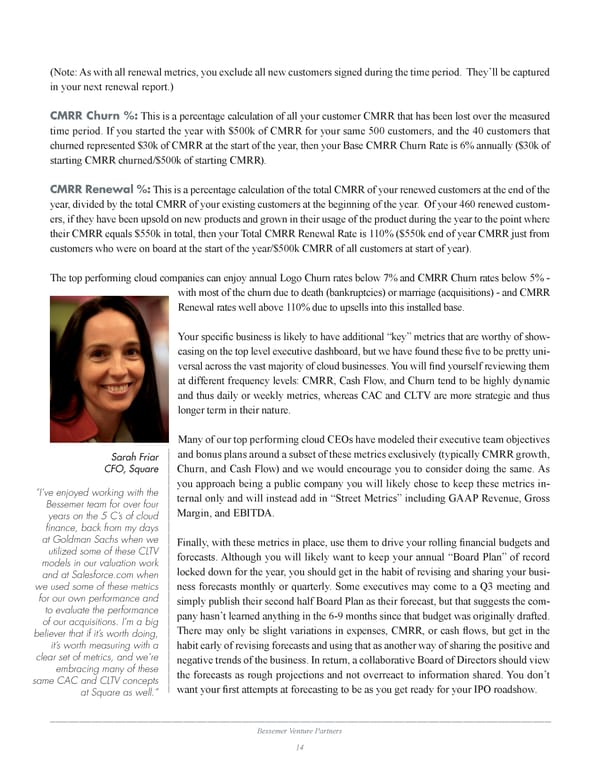(Note: As with all renewal metrics, you exclude all new customers signed during the time period. They’ll be captured in your next renewal report.) CMRR Churn %: This is a percentage calculation of all your customer CMRR that has been lost over the measured time period. If you started the year with $500k of CMRR for your same 500 customers, and the 40 customers that churned represented $30k of CMRR at the start of the year, then your Base CMRR Churn Rate is 6% annually ($30k of starting CMRR churned/$500k of starting CMRR). CMRR Renewal %: This is a percentage calculation of the total CMRR of your renewed customers at the end of the year, divided by the total CMRR of your existing customers at the beginning of the year. Of your 460 renewed custom- ers, if they have been upsold on new products and grown in their usage of the product during the year to the point where their CMRR equals $550k in total, then your Total CMRR Renewal Rate is 110% ($550k end of year CMRR just from customers who were on board at the start of the year/$500k CMRR of all customers at start of year). The top performing cloud companies can enjoy annual Logo Churn rates below 7% and CMRR Churn rates below 5% - with most of the churn due to death (bankruptcies) or marriage (acquisitions) - and CMRR Renewal rates well above 110% due to upsells into this installed base. Your specific business is likely to have additional “key” metrics that are worthy of show- casing on the top level executive dashboard, but we have found these five to be pretty uni- versal across the vast majority of cloud businesses. You will find yourself reviewing them at different frequency levels: CMRR, Cash Flow, and Churn tend to be highly dynamic and thus daily or weekly metrics, whereas CAC and CLTV are more strategic and thus longer term in their nature. Many of our top performing cloud CEOs have modeled their executive team objectives Sarah Friar and bonus plans around a subset of these metrics exclusively (typically CMRR growth, CFO, Square Churn, and Cash Flow) and we would encourage you to consider doing the same. As “I’ve enjoyed working with the you approach being a public company you will likely chose to keep these metrics in- Bessemer team for over four ternal only and will instead add in “Street Metrics” including GAAP Revenue, Gross years on the 5 C’s of cloud Margin, and EBITDA. finance, back from my days at Goldman Sachs when we Finally, with these metrics in place, use them to drive your rolling financial budgets and utilized some of these CLTV forecasts. Although you will likely want to keep your annual “Board Plan” of record models in our valuation work locked down for the year, you should get in the habit of revising and sharing your busi- and at Salesforce.com when we used some of these metrics ness forecasts monthly or quarterly. Some executives may come to a Q3 meeting and for our own performance and simply publish their second half Board Plan as their forecast, but that suggests the com- to evaluate the performance pany hasn’t learned anything in the 6-9 months since that budget was originally drafted. of our acquisitions. I’m a big There may only be slight variations in expenses, CMRR, or cash flows, but get in the believer that if it’s worth doing, it’s worth measuring with a habit early of revising forecasts and using that as another way of sharing the positive and clear set of metrics, and we’re negative trends of the business. In return, a collaborative Board of Directors should view embracing many of these the forecasts as rough projections and not overreact to information shared. You don’t same CAC and CLTV concepts want your first attempts at forecasting to be as you get ready for your IPO roadshow. at Square as well.” Bessemer Venture Partners 14
 Bessemer’s Top 10 Laws of Cloud Computing Page 13 Page 15
Bessemer’s Top 10 Laws of Cloud Computing Page 13 Page 15